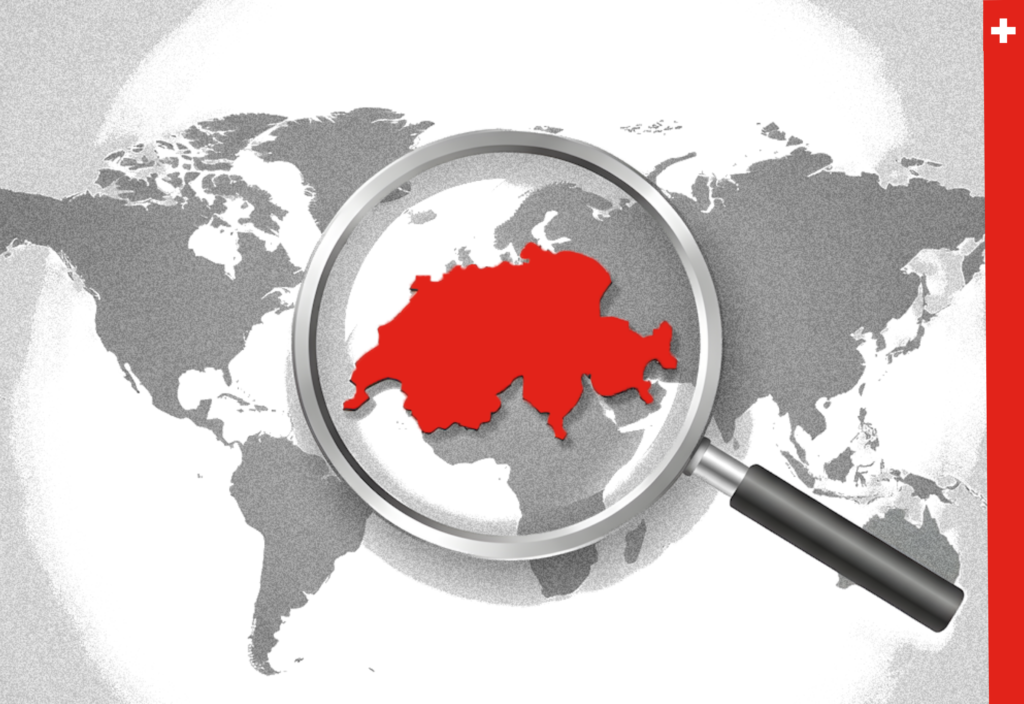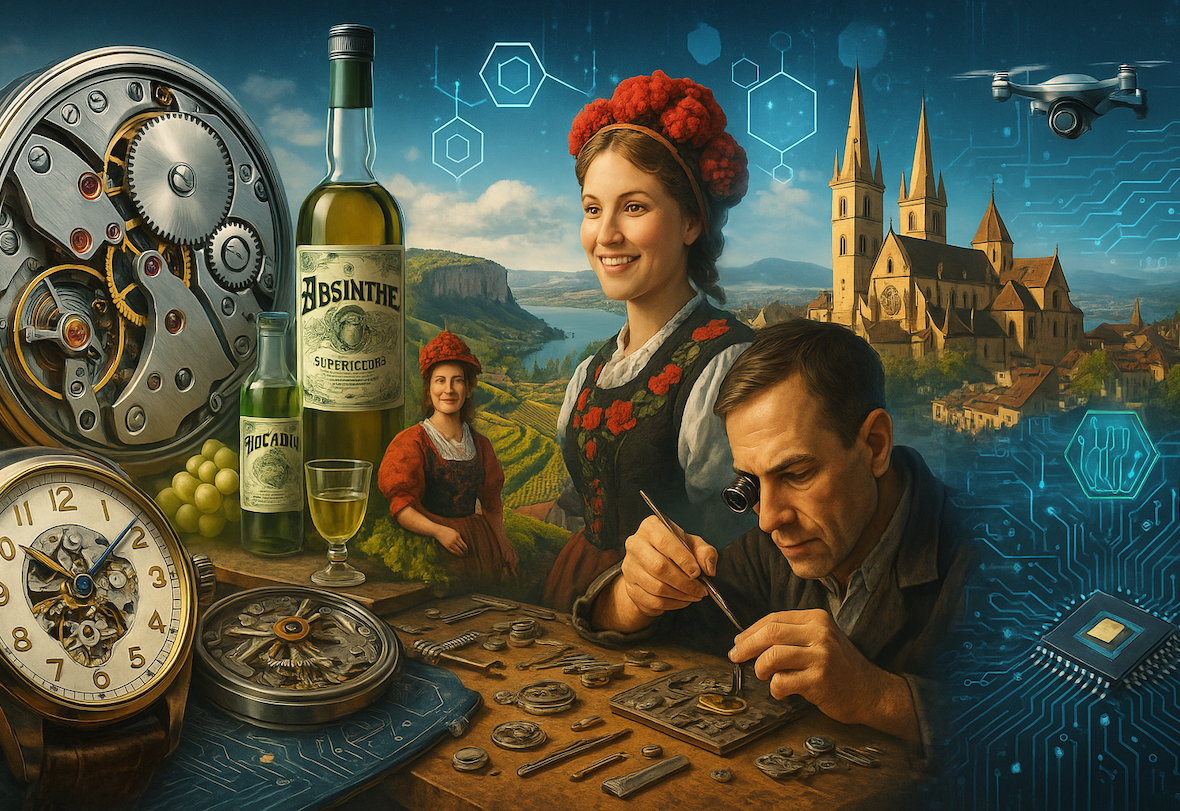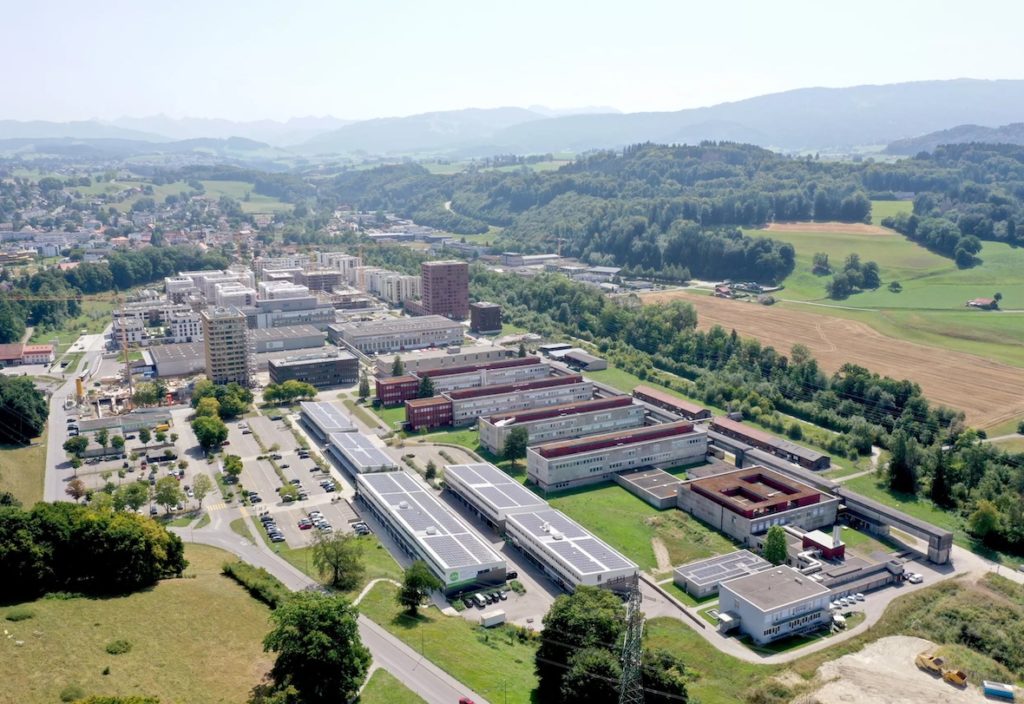
Neuchâtel, a legacy of precision driving tomorrow’s innovation
 A visual journey through Neuchâtel’s evolution from artisanal precision to cutting-edge innovation.
A visual journey through Neuchâtel’s evolution from artisanal precision to cutting-edge innovation.
Neuchâtel, renowned globally for its watchmaking heritage, has evolved into a dynamic hub of cutting-edge innovation. Today, the canton leverages its tradition of precision craftsmanship to excel in fields as diverse as blockchain, quantum technology, renewable energy, life sciences, and advanced manufacturing. The canton of Neuchâtel’s transformation highlights its unique ability to merge historical excellence with visionary innovation, positioning itself as a leading force within Switzerland’s economic landscape.
Situated at the heart of Western Switzerland, the canton of Neuchâtel has long been synonymous with precision, craftsmanship, and technological innovation. With its deep roots in a storied watchmaking past, Neuchâtel has seamlessly evolved into an internationally recognized hub of cutting-edge technology and industrial excellence. Today, this innovative spirit spans numerous sectors, from blockchain and quantum technology to cleantech, life sciences, and advanced manufacturing, marking a new era of economic dynamism.
This transformation is grounded in a centuries-old tradition of fine craftsmanship, initially expressed through world-renowned watchmaking. But the region also cultivated expertise in micromechanics, scientific instruments, and precision tooling, which are fields that naturally complemented and expanded upon horological skills. From early barometers and navigation chronometers to microfabricated components and optical devices, Neuchâtel steadily built a reputation for reliability and technical sophistication. These historical foundations laid the groundwork for the canton’s emergence as a leader in high-value, knowledge-based industries, where precision remains a hallmark, now applied to semiconductors, medtech, and digital technologies alike.
When watchmaking roots fuel modern innovation
Neuchâtel’s journey toward innovation began with watchmaking. Historically famed for exceptional precision in watchmaking, the region has continuously leveraged this heritage to foster technological advancements. The Métiers du Temps | Time Arts (MTTA) initiative exemplifies this synergy. Recognized nationally for its significance, MTTA, based in Le Locle, unites major watchmaking groups, artisans, and researchers, preserving traditional craftsmanship while propelling industry advancements through cutting-edge research and education. The Federal Department of Economic Affairs, Education, and Research recently awarded CHF 1.6 million to MTTA, underscoring its national strategic importance.
Complementing this tradition, the University of Neuchâtel (UNINE) has also developed innovative precision technologies, notably an ultra-miniaturized atomic clock crucial for future lunar exploration and precise geolocation. The clock, employing rubidium atom oscillations measured by lasers, is instrumental in coordinating lunar time (LTC), vital for missions and lunar base operations. This pioneering spirit reinforces Neuchâtel’s global leadership in precision technology.
A quantum leap forward
Building upon its precision timekeeping legacy, Neuchâtel recently welcomed Rolex Quantum SA. Based at the historic Neuchâtel Observatory, Rolex Quantum collaborates closely with the Swiss Center for Electronics and Microtechnology (CSEM) to develop optical atomic clocks. These innovative clocks utilize rubidium atoms and offer unprecedented accuracy for applications in GPS, telecommunications, and international time standards. This strategic collaboration places Neuchâtel at the forefront of global quantum technological advancements, highlighting its dedication to precision beyond traditional watchmaking.
A blockchain and fintech revolution
Parallel to its precision heritage, Neuchâtel has emerged as a vibrant crypto and blockchain hub, earning recognition as Switzerland’s crypto haven. The canton actively supports blockchain enterprises, with over 90 companies in this sector, facilitated by dedicated infrastructures such as Coworking Blockchain Neuchâtel (CBN). Opened in July 2025, this innovative coworking space features private offices, flexible workstations, and a public “Coffice,” promoting collaboration among entrepreneurs, tech experts, and the public.
Moreover, Neuchâtel has hosted significant blockchain-focused events, such as Le Paradigme Bitcoin, attracting key figures and fostering discussions on blockchain’s intersection with traditional industries like watchmaking. The canton’s membership in the Swiss Blockchain Federation since January 2023 further solidifies its position as an essential node in Switzerland’s fintech landscape.
Neuchâtel also attracted innovative blockchain-based logistics companies such as ADMCS, which, through its Swiss subsidiary DMCS Software, is revolutionizing global container transport. Its blockchain and tokenization-driven platform, SIRIUS, optimizes container rotation, enhances operational efficiency, and significantly reduces environmental impact. Neuchâtel’s forward-thinking regulatory environment and strong support from local economic agencies, including GGBa and Neuchâtel Economie, have enabled ADMCS to flourish and further strengthen the canton’s leading role in blockchain innovation.
Cleantech innovations
Neuchâtel’s commitment to sustainability is evident in numerous cleantech initiatives. Sun-Ways’ groundbreaking solar project integrates removable solar panels within active railway tracks, marking a revolutionary approach to renewable energy infrastructure. This pilot project in Buttes could potentially extend across Switzerland’s extensive railway network.
Additionally, VARO Energy Group and Groupe E have established Switzerland’s largest ground-mounted solar park in Cressier, boasting 19,000 photovoltaic panels and an impressive capacity of 7.7 MW, powering the country’s only refinery. Collaborations such as EPFL and CSEM’s record-breaking tandem solar cells, achieving over 30% efficiency, significantly advance photovoltaic technology.
The CSEM Battery Innovation Hub, inaugurated in February 2023, represents another milestone, fostering research into advanced battery technologies crucial for energy storage and sustainable development. Over 50 researchers across disciplines aim to position Switzerland as a leader in battery innovation, vital for electric vehicles and grid management.
Advanced manufacturing excellence
Neuchâtel’s industrial prowess extends into advanced manufacturing and medical technologies, exemplified by global enterprise Jabil’s state-of-the-art facility in Le Locle. Specializing in precision manufacturing of spinal implants and surgical instruments, Jabil employs approximately 400 professionals, utilizing advanced manufacturing capabilities and collaborating with local academic institutions such as Microcity, EPFL, ETH Zurich, and HE-Arc.
Further strengthening its advanced manufacturing sector, the Micromanufacturing Science & Engineering Center (M2C), established by EPFL’s Institute of Electricity and Microtechnology (IEM) and CSEM, accelerates innovation in additive manufacturing and micro-fabrication technologies. The M2C platform actively promotes economically viable, environmentally sustainable manufacturing solutions, bridging academic research and industrial applications to maintain Switzerland’s global competitive edge.
Life sciences and diagnostics hub
Neuchâtel also distinguishes itself in life sciences through the Human Lean Diagnostics (HLD) cluster, which welcomed its first tenants in June 2025. Located in the Serrières Valley, HLD provides state-of-the-art infrastructure for medical diagnostics innovation, focusing on personalized medicine, point-of-care diagnostics, digital health solutions, and automation. The cluster fosters collaboration among academia, industry, and start-ups, positioning Neuchâtel prominently within Western Switzerland’s Health Valley.
WuXi STA, a subsidiary of WuXi AppTec, has chosen Neuchâtel for its first European site, located in Couvet. Specializing in API and drug product manufacturing, the facility benefits from the region’s industrial know-how and integrated infrastructure. Neuchâtel’s location, skilled workforce, and supportive ecosystem make it an ideal base for global pharmaceutical operations.
Building on a long-standing presence in the region, Japanese pharmaceutical group Takeda is investing CHF 200 million to expand its biotechnology site in Pierre-à-Bot. The project includes the construction of a new aseptic filling line and additional production capacity, creating 40 highly skilled jobs. The site, which plays a key role in the company’s global supply of recombinant therapies for hemophilia, already serves over 70 markets and employs some 700 people. Takeda’s deepening engagement in Neuchâtel is further supported by partnerships with local authorities to develop training programs and strengthen its regional talent pipeline.
Semiconductor and AI investments
Recognizing the strategic importance of semiconductors in the global digital economy, the canton of Neuchâtel has invested CHF 3 million to modernize the MEMS (Micro-Electro-Mechanical Systems) manufacturing line at CSEM. This forward-looking initiative aims to boost regional expertise in advanced microfabrication, essential for applications ranging from sensors and biomedical devices to next-generation communication technologies. By upgrading cleanroom infrastructure and process capabilities, the investment ensures that Neuchâtel remains at the forefront of innovation in the semiconductor value chain. To explore more concrete examples of cutting-edge technologies developed in Neuchâtel, see our article on top innovations from CSEM.
Moreover, Neuchâtel’s AI-powered Industrial Smart Map has garnered national recognition as a pioneering tool in economic promotion. Developed to offer a real-time, data-driven overview of the canton’s industrial ecosystem, the platform uses artificial intelligence to dynamically map out companies, their specialties, markets, and interconnections. This interactive resource not only highlights Neuchâtel’s technological and industrial strengths across sectors like watchmaking, medtech, microtechnology, and ICT, but also serves as a practical tool for investors, recruiters, and public authorities. By visualizing business clusters and innovation potential with precision, the Smart Map facilitates strategic decision-making and reinforces the canton’s positioning as a competitive, high-value industrial region.
Infrastructure for collaborative innovation
Neuchâtel continues expanding its innovation infrastructure through projects like JD7, designed for eco-efficiency, collaboration, and adaptability. This CHF 70 million investment provides over 10,000 square meters of space, primarily housing CSEM, start-ups, and research centers. JD7’s circular architecture promotes natural lighting and interaction, integrating sustainability features like renewable energy sources.
Additionally, Microcity stands at the heart of Neuchâtel’s innovation landscape, serving as a dynamic hub where cutting-edge research meets entrepreneurial drive. Bringing together key players such as CSEM, EPFL, and a growing network of start-ups and R&D centers, Microcity fosters cross-sector collaboration in fields ranging from microengineering to energy efficiency and digital technologies.
Among the companies that have chosen Microcity as their base is Aranow Swiss, a spin-off of the Spanish Aranow Packaging Machinery group. The company develops sustainable packaging solutions with a focus on research and innovation, benefitting from the collaborative environment and technical expertise available in Neuchâtel. Its presence illustrates how the canton attracts international industrial actors seeking proximity to Western Switzerland’s innovation ecosystem.
As a member of Switzerland Innovation Park Network West EPFL, Microcity promotes technology transfer and the emergence of high-value industrial projects by offering specialized infrastructure and access to academic expertise. To accommodate increasing demand and amplify its impact, the platform is currently undergoing a major expansion. The new building, scheduled for completion between 2025 and 2026, will offer 10,000 square meters of additional space, including shared laboratories, offices, and communal areas designed to stimulate co-creation. This strategic development will not only enhance Neuchâtel’s innovation capacity but also further position the canton as a leading environment for industrial transformation and technological excellence.
Education as a catalyst for innovation
Neuchâtel’s innovation capacity is deeply rooted in the strength and complementarity of its higher education institutions. The University of Neuchâtel (UniNE) stands out for its interdisciplinary research and international outlook, with strong faculties in sciences, economics, law, and humanities. Its Institute of Statistics, the Center for Hydrogeology and Geothermics, and the Laboratory for Cognitive Science have earned international recognition, while its master’s programs in areas like applied economics and data science attract students from around the world. The university also plays an active role in regional economic development by partnering with local companies and public institutions on research and innovation projects.
Complementing this academic foundation, the Haute Ecole Arc (HE-Arc), whic is part of the University of Applied Sciences and Arts Western Switzerland (HES-SO), offers applied, practice-oriented training in engineering, health, conservation, and management. Its Microengineering School in Neuchâtel is particularly renowned, maintaining close ties with the watchmaking, medtech, and precision industries through collaborative research and internships. The school is also involved in cutting-edge areas such as additive manufacturing and Industry 4.0, helping to equip students with the technical and entrepreneurial skills needed in fast-evolving industrial sectors. Together, these institutions form a robust talent and innovation pipeline that supports the canton’s transition from its horological heritage to a knowledge-driven economy.
Where tradition meets transformation
Neuchâtel’s journey from the birthplace of Swiss watchmaking to a world-class innovation hub speaks to more than just economic reinvention. It reflects a legacy of precision, creativity, and adaptability, qualities that have positioned the canton at the forefront of breakthrough fields such as quantum technology, cleantech, semiconductors, life sciences, and blockchain.
This transition has been driven by forward-looking public investments, a robust innovation infrastructure, and a strong culture of collaboration across sectors. With institutions like EPFL, HE-Arc, CSEM and Microcity at its core, Neuchâtel offers a fertile environment where research, education, and entrepreneurship converge. The region is also home to a thriving ecosystem of companies, spanning multinationals and nimble start-ups, that are shaping the future of manufacturing, healthcare, and digital technologies.
Looking ahead, the canton is sharpening its focus on the widespread adoption of artificial intelligence, particularly among SMEs and the general public. This emphasis on digital inclusion is paired with efforts to democratize access to blockchain and crypto-based technologies, ensuring that innovation reaches all levels of society. By making these powerful tools accessible beyond large corporations, Neuchâtel aims to accelerate transformation across its economic fabric.
With strategic priorities centered on digital transformation, sustainable growth, and scientific excellence, Neuchâtel is not just a symbol of Swiss ingenuity, it is a living example of how heritage and innovation can converge to shape a dynamic, resilient, and globally connected future.

